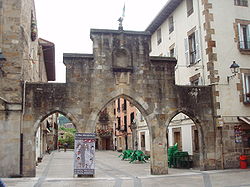Elorrio | |
|---|---|
 An archway in Elorrio | |
| Nickname: Elorrixo | |
| Coordinates: 43°7′50″N 2°32′34″W / 43.13056°N 2.54278°W | |
| Country | |
| Autonomous community | |
| Province | Biscay |
| Comarca | Durangaldea |
| Founded | 1356 |
| Government | |
| • Mayor | Ana Otadui (EAJ-PNV) |
| Area | |
• Total | 37.32 km2 (14.41 sq mi) |
| Elevation | 185 m (607 ft) |
| Population (2018)[1] | |
• Total | 7,336 |
| • Density | 200/km2 (510/sq mi) |
| Demonym(s) | Spanish: elorriano (ana) Basque: elorriotarra |
| Time zone | UTC+1 (CET) |
| • Summer (DST) | UTC+2 (CEST) |
| Postal code | 48230 |
| Website | Official website |
Elorrio is a town and a municipality located in the eastern part of the province of Biscay, in the Basque Country, in northern Spain. As of 2017[update], it has a population of 7,307 inhabitants.[2] It covers an area of 37.20 square kilometers and it has a population density of 193.58 people per square kilometer. It holds the medieval title of Most Loyal and Noble Villa (Spanish: Muy Noble y Muy Leal Villa).
Elorrio was founded in 1356 by the Infante Tello Alfonso of Castile, who was the 20th Lord of Biscay, near the elizate of Saint Agustín of Etxebarria (Basque: San Agustin Etxebarria; Spanish: San Agustín de Echevarría). Historically, San Agustin Etxebarria was part of the medieval County of Durango, and Elorrio remains part of the comarca (local region) of Durangaldea. In 1630, Elorrio annexed Saint Agustín of Etxebarria, which today is a ward of Elorrio. Elorrio had municipal representation in the medieval Juntas Generales.
The town has been affected by its main economic activity: the industrial sector. It is also renowned for its rich architectural heritage, being listed as a Conjunto histórico by the Ministry of Culture.
- ^ Municipal Register of Spain 2018. National Statistics Institute.
- ^ "Bizkaia: Población por municipios y sexo" (in Spanish). INE. Retrieved 2 February 2018.


